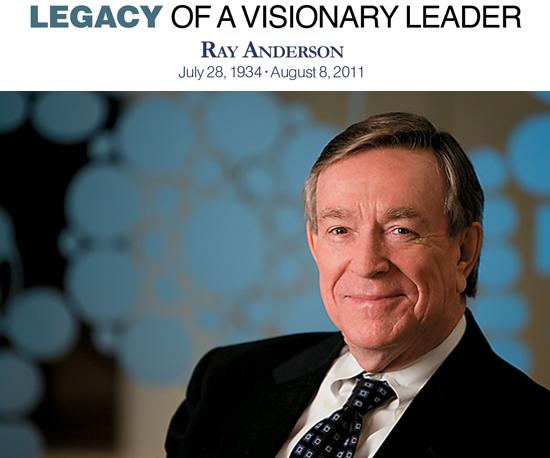Legacy of a Visionary Leader - December 2011
With his vision, conviction and perseverance, Ray Anderson not only forged the path for modular carpet tile—which is now the fastest growing product in the commercial flooring market—but he also led the entire flooring industry on a trek toward sustainability. Like every truly dynamic leader, Ray knew how to choose the right people to help him make his vision a reality, and he also knew how to convince them to follow him wholeheartedly into a new venture. Much like Steve Jobs at Apple, Ray had the ability to envision the whole picture and therefore see all the missing pieces in the puzzle.
Even early stories from Ray’s life give an indication of the man he would become. On Ray’s blog, a West Point High School classmate named Harold Weathers shared a story of his first introduction to Ray in 1943, when Ray was only nine years old. Harold was a new student at the school and too timid to join the other boys in a game called toss-up, which used a crumpled up piece of notebook paper as a ball. Harold wrote, “Noticing me, Ray left his group and came and sat down by me and began to ask questions about my life such as where had I previously gone to school, did I have any brothers or sisters, where did I live, etc. He then explained the game toss-up and invited me to join them in the game. That early initiative by Ray made me a full-fledged member of the class from that day on. Ray and I engaged in numerous hours of team sports through our elementary and high school years. The culmination was during our senior year when he was the team’s quarterback, and I played at what is today referred to as a tight end. This all began with a piece of crumpled up notebook paper and a young boy who was wise and kind beyond his years.”
Ray wasn’t a man to sit back and let life happen around him. He frequently reminded his employees, “The next order is the heartbeat of the company.” And he was willing to do whatever it took to keep that heart humming, whether waking up in the middle of the night to scribble down innovations he’d dreamt up or challenging his employees to climb Mount Sustainability with him. When Ray died of cancer on August 8, the industry lost a great thinker, and many people lost a great leader and friend. Dan Hendrix
Dan Hendrix
CEO of Interface
I started at Interface in 1993 when the company was ten years old. Pretty early on, Ray and I connected personally and professionally. He gave me a lot of responsibility at an early age and held me accountable to it. I became one of his confidantes. He taught me how to be tough and competitive. He also taught me how to balance family life and business. Ray was a friend, a colleague, a mentor, and an inspiration in my career.
My favorite story about Ray took place when Interface was about to go public. The company was about 10 years old then. When a company goes public, the first ten pages of the Initial Public Offering (IPO) tell the story of the company. Lawyers draft the IPO statement, which outlines how they plan to position the company and market it.
When the lawyers presented their statement about Interface to Ray, I was in the room and had never had much exposure to Ray up until that point. There were 15 people around the table, mostly lawyers and investment bankers. He read the document and then said, “This isn’t my company.” He spent a few hours rewriting it at the table, then he handed it back and said, “This is my company.”
At that time, Interface had $52 million in annual revenues. Ray believed that the company would go global, that the whole world needed modular carpet. He said Interface would be a billion dollar company in ten years. He could see his vision and was committed to going after it.
One of the best things about Ray was that he listened to his customers and tried to solve their problems. He sold his customers what they needed, not what he had made. He was always looking for the next vision.
Ray had a swagger and a smile that was infectious. He was humble and came from humble roots. He created a culture where people wanted to hang around with him. He was fun. He laughed. He was witty, competitive, fierce. A great listener. All of this transcended into Interface’s culture. As a company, we embody his personality.  Don Russell
Don Russell
original investor and the original VP of sales and marketing for Interface
I met Ray in 1965 after I was honorably discharged from the Navy and looking for a job. My job search took me to Callaway Mills in LaGrange, Georgia. Ray, at that time, worked at Callaway. I had an interview with the company, and I was fortunate enough to be offered a job there by Ray.
I became friends with Ray, a friendship that endured until his death. In 1968, I left Callaway to go with another company in North Georgia. While I lived in North Georgia, Ray and I saw each other quite often. We talked about businesses that we would like to start together. He was investigating an association with Carpets International then. When he finalized it, he invited me to join him to create the company that we now call Interface. I put every penny I had into the company. I went to work for Interface broke.
There were three of us then: Ray, Joe Kyle and myself. We worked out of the spare bedroom in my home. I always joke that Interface’s first piece of capital equipment was a telephone cord extension, which I don’t think I ever got paid for.
Originally, Ray was president, Joe Kyle was VP of manufacturing and I was VP of sales and marketing.
Ray said to me, “What do you know about sales?”
I said, “Nothing.”
He said, “What do you know about marketing?”
I said, “Nothing.”
He said, “Okay, we’ll learn together.”  Mary Anne Lanier
Mary Anne Lanier
daughter of Ray Anderson
I am the older of Ray Anderson’s two daughters. From the time I was a young girl, Daddy was my hero, the one person who had an answer to every question I ever asked.
Daddy was a fierce competitor, something he learned on the high school football field where he was quarterback, running back and kicker for a state championship team—it was a very small school. He was driven to always be better, and he had a way of making everyone around him want to be better as well. No one ever wanted to disappoint him.
He invested his life savings into the start up of Carpets International-GA, Inc. and in his mind failure was not an option. It was a terrifying time for our family. My grandfather finally stopped worrying about his son’s venture and considered it a success when the plant began to operate three shifts a day. As a petrochemical intensive product, the company survived against all odds, since it was founded in 1973—at a time when, thanks to the first oil crisis, all petroleum raw materials were in short supply.
My father was always thinking. He kept a gray notepad by his bed and would wake up to scribble down ideas or questions before he “lost the thought.” The next morning at work, he would pass the note along to the person he thought most likely able to find the answer. I don’t think he ever realized how those two-line memos created two months of work for the recipient.
Daddy never stopped learning. He always wanted to speak from a point of knowledge and made it a point to learn everything he could from the most knowledgeable people he could find on any given subject. He indulged his girls with trips to the beach even though he couldn’t stand the beach himself. The day before we would leave on those vacations, he would visit the local library and arm himself with a stack of books two feet high. While we enjoyed the sand and the surf, he would read. He had a real gift for absorbing information and being able to recall it in great detail. We came home from those vacations suntanned and happy. He came home smarter. 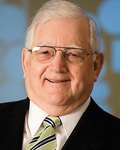 Don Lee
Don Lee
original investor and the original VP of finance for Interface
I worked for Milliken and was transferred to LaGrange in January 1970. I met Ray at Milliken, and we became very close friends. When he started Interface, he asked me to join him.
At that point, I had worked with Milliken for over 13 years, ever since I graduated from the University of South Carolina. I had 11 different promotions with the company. However, at Milliken, the largest private company in the world at the time, an employee couldn’t buy a share of stock in the company.
Three or four years prior to the opportunity with Ray, I had made up my mind to start looking for an opportunity to become part owner in a company or to at least to work for a company that I could buy stock in. When I got the opportunity to go with Ray, it was a chance to roll the dice. I thought we could make it work. I took a second mortgage on my home. I took a cut in pay even though I had two daughters in private school. I believed it was a great opportunity. I just felt good about it. I was willing to take the chance.
On a daily basis, Ray would say, “If we don’t get that next order, we’re out of business.” We did what we had to do to get it. The company grew 75% per year during the first ten years.
Ray was always very superstitious. As a matter of fact, when Ray bought the property to build the plant on, he found a horseshoe on the property. He had that horseshoe framed and always said, “We have luck on our side now.” I guess he was right.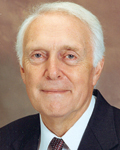 Graham Scott
Graham Scott
early engineer at Interface and advisor to Ray Anderson
I met Ray in England around 1970. Ray came to look at what we were doing at Carpets International with making carpet tiles. He went back to the States, and when he returned, he had put together a group of private investors in LaGrange to form Carpets International Georgia Inc..
I came to LaGrange in 1974 to assist with some of the equipment. I intended to stay for two weeks. But right away I could tell that this was an exciting company, something I wanted to be part of. I wanted to go fetch my family right away and bring them to Georgia. Thirty-seven years later, I’m still here.
What attracted me to the company in the first place was Ray’s demeanor. He had created what seemed to be an exclusive club with some basic rules. One of the big rules, which he always pushed, was that the next order is the heartbeat of the company. A great thing to live by. Another was, never say it can’t be done. I’ve never forgotten that.
Because Interface’s success was starting to show, the parent company offered me an attractive position back in Britain. I talked to Ray about it. He said, “It’s your decision to go back if you wish, but I’m building something special here, and I’d like you to help me build it.” That really resonated with me, and, of course, I was going nowhere after that. He was asking me to build something special and make a good living while I was doing it—that was a combination that I couldn’t pass up.
We went along for years quite happily after that, then he dropped a bomb on all of us. Around 1990, one of our executives asked what the company’s environmental position was and invited a group of executives to discuss it. Ray was invited to open the discussion. He stood up and said, “At first when you asked me, I didn’t know what I was going to say, but I just read The Ecology of Commerce, and it had quite an affect on me. We’re going to become a sustainable company.”
After listening to him speak for a while, I started thinking, gee whiz, how much material have I sent to the landfill by association? I felt such guilt. I had consumed energy and resources for what? My actions hadn’t had much effect on improving life for anyone. I felt pretty bad about it, and I let everyone know that I was going to do something about it.
Ray stunned a lot of us into dedicated action by passing along what he was learning about sustainability. The more he found out, the more he passed along. Famous names in the environmental movement, like Greenpeace, would come and talk to the entire staff about the environment.
Many people have asked, why did Interface become so environmentally engaged? It was because of one man’s vision.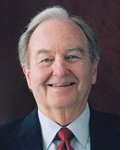 Smith Lanier
Smith Lanier
original investor in Interface
My wife and Ray were high school classmates, and in the early days of my marriage we had a supper club together. Ray worked for Milliken then but was always looking for a venture that he could get into on his own.
I had my own business, and Ray would come to me with different inventions, wanting to know if I thought we could get the investment to get them started. Mostly, he would come back a few weeks later and say, “No, that wasn’t the right idea.” But when he came to me with Interface, he said, “This is it.”
I asked how much money we’d need. He said half a million, and I said, “Yes, I think we can do it.”
We met with Carpets International at Callaway Gardens and convinced them that we could raise a half million. When they took the deal, we were dumbfounded.
My family had just gotten out of a venture, so we put up a fifth. Ray and Joe each put up a fifth. Some others invested, and we were off to the races.
Ray was an entrepreneur. He wanted to do things. He didn’t want to just sit back and play second fiddle. He understood what business was, the big picture. Most people don’t understand the big picture like Ray did. He tackled the big picture and that’s what made Interface successful.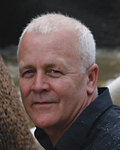 John Picard
John Picard
the architect/customer who challenged Ray Anderson to consider Interface’s environmental impact
I was the environmental consultant for Southern California Gas Company’s Energy Resource Center in the early nineties. It was a massive project for its time, a brilliant opportunity to integrate green and sustainable building practices. At that time, green was people living off the grid in the mountains; it certainly wasn’t a 100,000 square foot super modern commercial building in the city of Downey. I had read Paul Hawken’s The Ecology of Commerce, so I started studying carpet, and nylon in particular, and I realized that it had great potential for recyclability. I began talking to manufacturers—Interface wasn’t the first—and I got the door slammed on me. I got angry, and I decided that I was going to go to the top. I searched out Ray through Joyce LaValle.
I got to sit down with Ray in Atlanta and talk about my ideas, but our conversation really wasn’t going where I wanted to go. I said, “Ray, Interface just doesn’t get it.”
That tapped a brake on in his head. He asked, “What don’t we get?”
I told him, “You guys need to take a look at what you do and what you make and at the opportunity to make something different.” This intrigued him. He started asking a lot of questions.
I knew that I wanted to try to reclaim old carpet to make new carpet. I asked Ray if we could figure out a way to do a lease for the carpet tile at the Energy Resource Center. He said that he was willing to figure out the financing, but that Interface didn’t have the ability to make new carpet from old carpet at that time—no one did. But before I knew it, he was engaged in the project, and it actually happened: we installed the carpet at Energy Resource Center with the intent of making it into new carpet again, which they did.
In a sheer flash of genius, Ray realized that this might be the competitive advantage that Interface needed. Until he read Hawken’s book, he didn’t understand how to measure a company’s impact on the planet, but he really went from not getting it to really getting it. Ray thought beyond most people. He had the ability to look out, almost into the impact on the next generation. In terms of engineering, Ray could envision the outcome like it was already built. He was unstoppable because he got to the full result in his head, and there was no way you could take that away from him. There is not another Ray Anderson in the world.
Ray chose to take on sustainability when the company really couldn’t afford it, but he stayed focused. Ray never once hesitated to do the right thing. He never stopped pushing the company to be the leader in sustainability. Every breath he took was mission critical to proving that Interface could be the most sustainable company in the world. Ray’s whole mission was sharing, exposing the secret codes to doing right and hoping and believing that everyone would want to follow. He switched on at 60 years of age. How many people hit the go button at 60? For Ray, there were no borders, no limits. I often ask myself, what would Ray do? When I ask that question, I always get the right answer.
|
PAUL HAWKEN EULOGY |
|
Excerpt from a eulogy of Ray Anderson by Paul Hawken, environmentalist, entrepreneur, co-founder of Biomimicry Technologies, and author of six books including The Ecology of Commerce, which Ray Anderson credited as the "spear in the chest" that started his environmental awakening. |
Copyright 2011 Floor Focus
